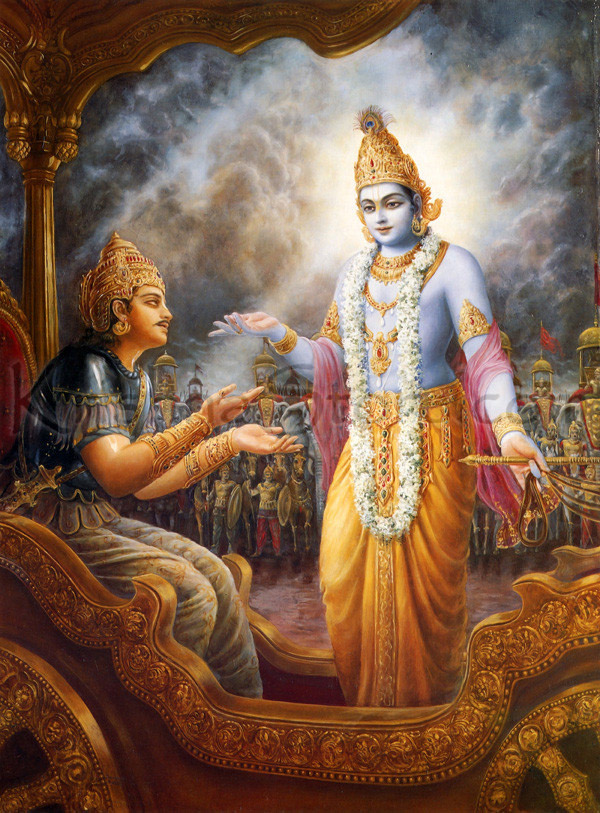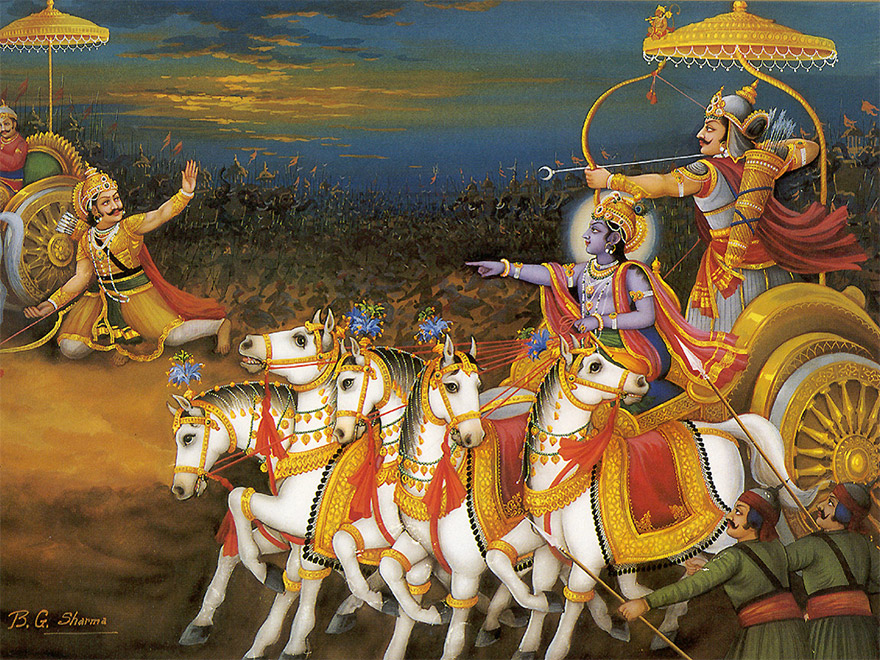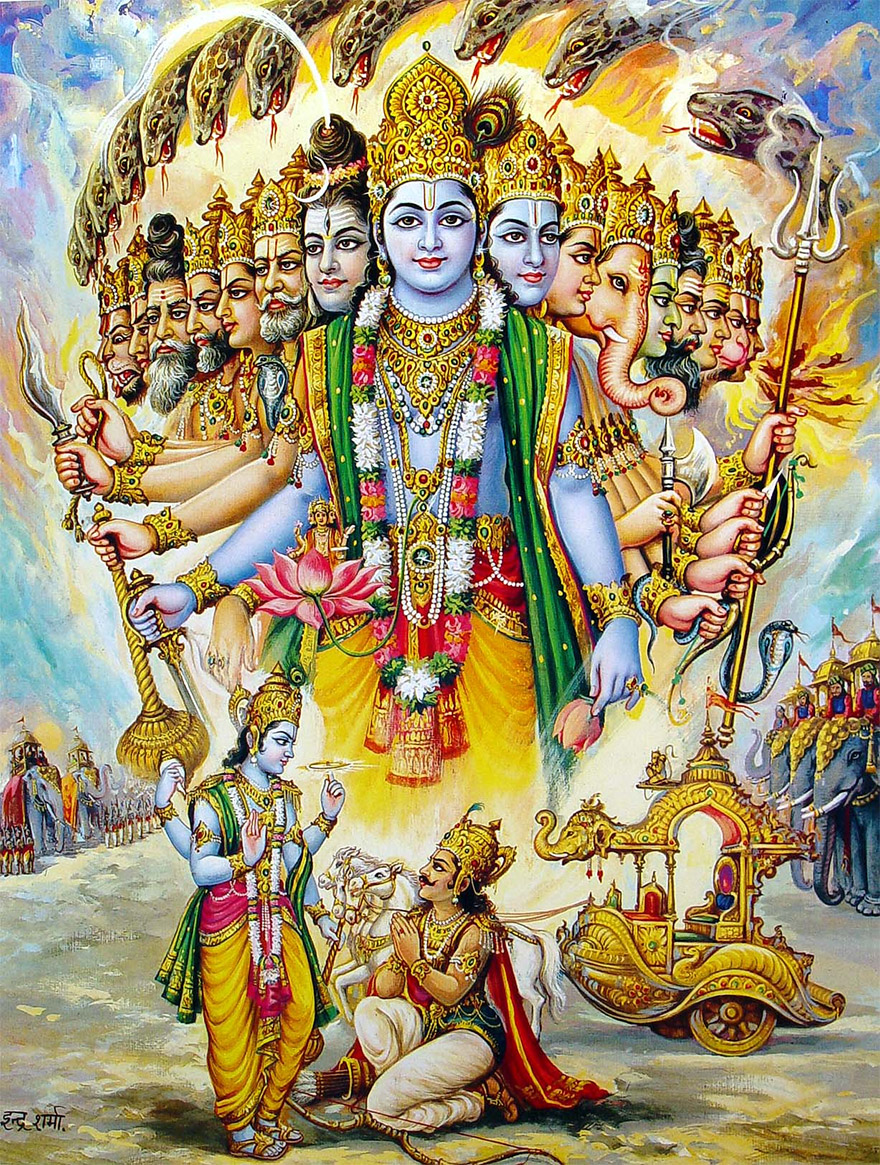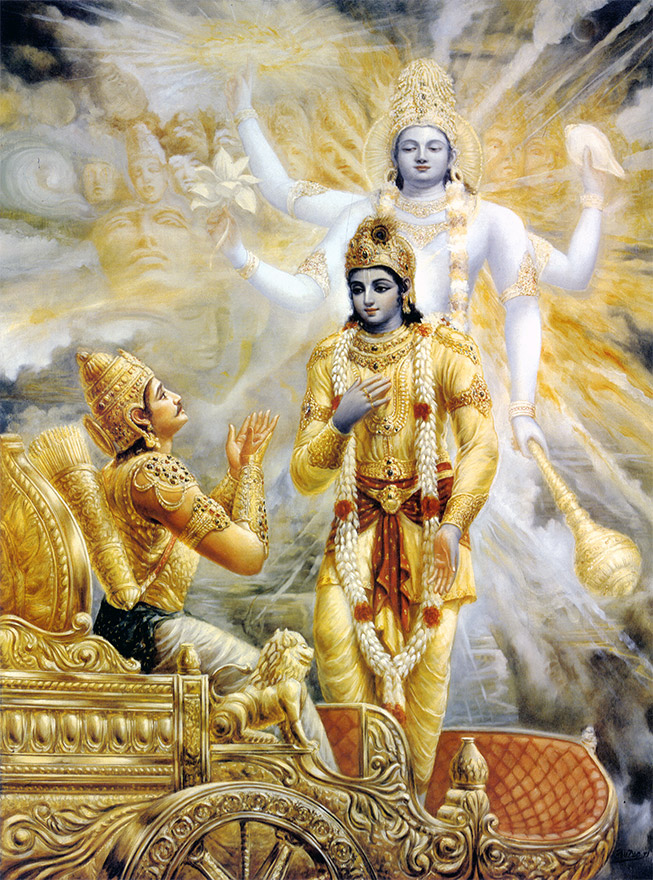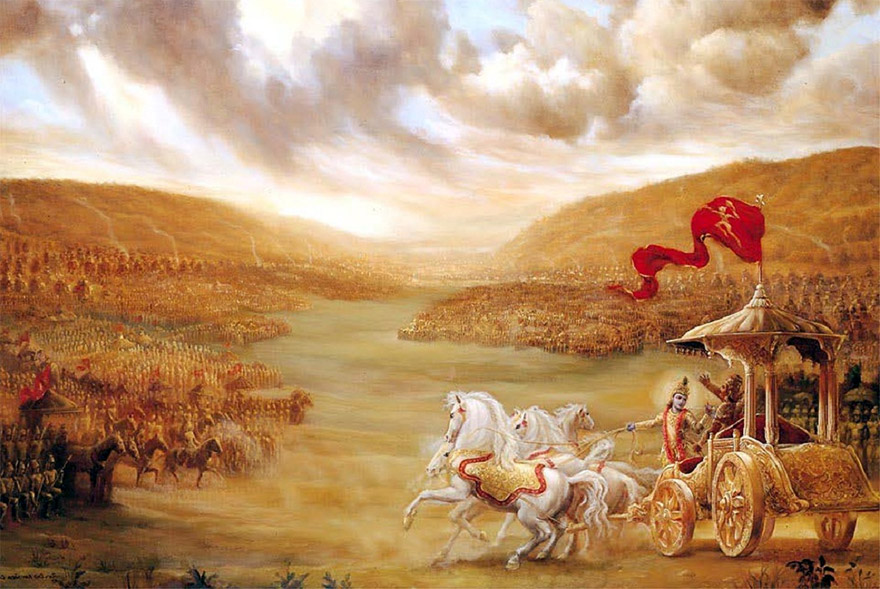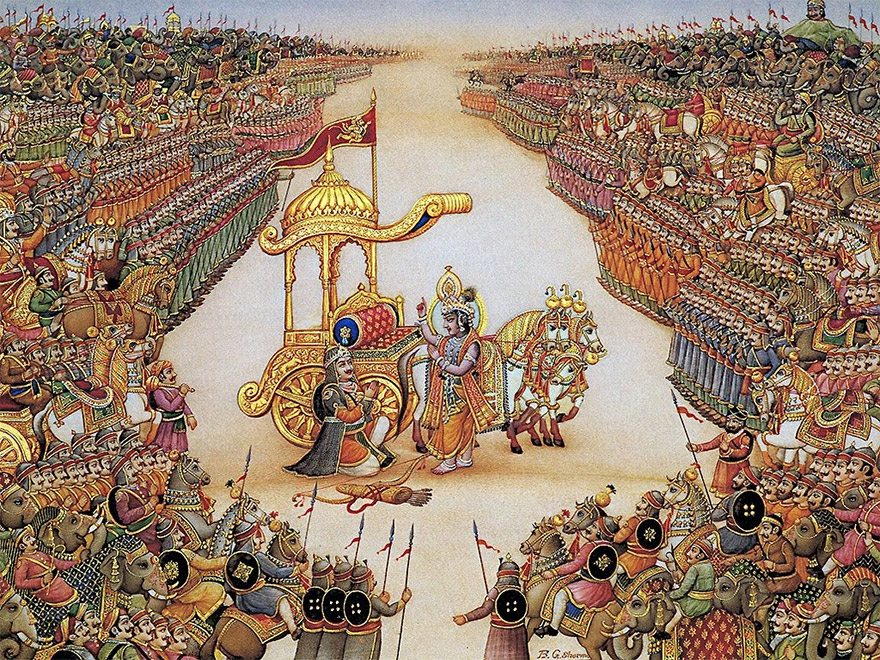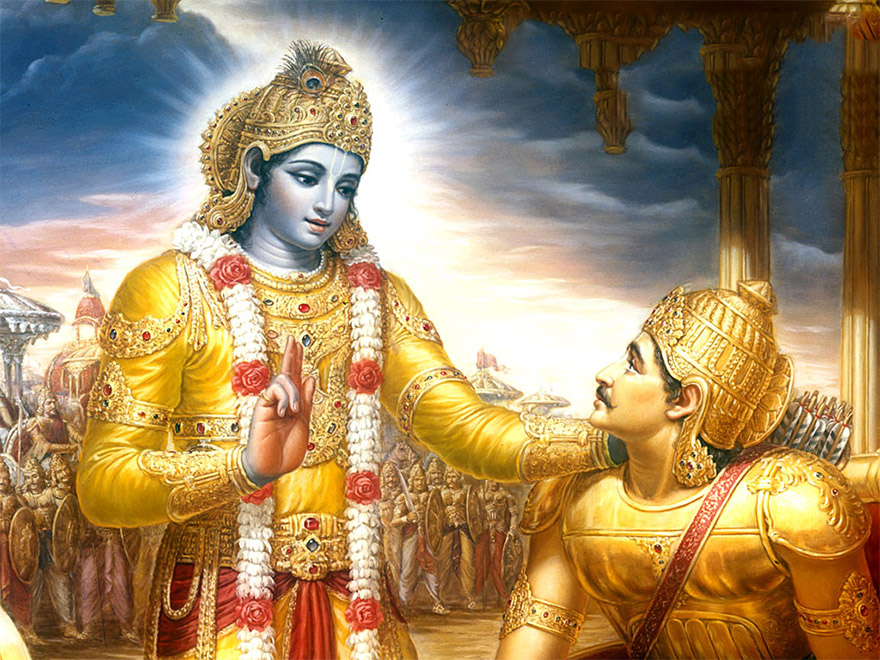Dharma is a very familiar term in Hindu epics, purāṇas and other literary works that highlight the ideal ways of human life. We find the term in the major Upaniṣads and Bhagavad Gīta also, used in varying senses like virtue, righteousness and religious duties. Bṛhadāraṇyaka Upaniṣad says in verse 1.4.14 that Dharma is instrumental in making the world flourish; in the beginning, it was created on finding that world was not flourishing through the earlier creations of four Varṇas.
Taittirīya Upaniṣad (1.11.1) insists that Dharma should be strictly observed in life, without fail. In Chāndogya 2.23.1 three types of Dharma (religious duties) are prescribed. Thus scriptures assign great importance to Dharma. Nevertheless, this term is not seen defined anywhere exhaustively. If Dharma exercises so great an influence in human life as indicated, we should definitely find out what it exactly consists of. Let us here make an enquiry for the purpose.
[wp_ad_camp_1]
In the first chapter of Gīta on ‘Despondency of Arjuna’ (अर्जुन विषाद योग – Arjuna viṣāda yoga) Arjuna laments about the probable breach of Dharma that he may incur if he kills his close relatives, preceptors and friends in the battle. At the moment of commencing the fight, Arjuna became grief-stricken and confused on seeing his own relatives, Bhīṣma in particular and also Gurus, on the opposite side. The very thought of killing them in battle was excruciating for him. He was ready to forsake anything including his life for their good. He makes his own evaluation on what to do or not to do at the moment, weighing all the options on the touchstone of Dharma.
Arjuna’s thoughts proceeded on these lines: ‘I am not delighted in killing the Sons of Dhṛtarāṣṭra since they are my relatives; slaying one’s own people is a sin. Even if they don’t realise what will happen if one’s own clan is ruined, we are well aware of it. When the clan is ruined, its age-old Dharma will decline and Adharma will take its place. Adharma will cause the women of the clan to be immoral, which in turn will result in varṇasaṅkara (mixing of varṇas). As a result, the whole clan will be destined to hell; forefathers will be deprived of the offering of piṇḍa and water and consequently, they also will fall into hell. Varṇasaṅkara will also cause erosion of caste-dharma(s). With all the Dharmas lost in this way, what awaits us is permanent lodging in the hell. It is pity that we have resolved to commit such a great sin by killing our own people, simply for wresting the throne. It would be better for us if the sons of Dhṛtarāṣṭra kill us when we are not fighting and without arms.’ Deeply moved by these thoughts Arjuna gave up his arms and sat down in the chariot with great sorrow.
Thus, Arjuna’s thoughts are singularly concentrated on Dharma and its possible violation in his actions. But what does he understand about Dharma? To him, killing one’s own kinsmen is not Dharma under any circumstance. He fears that such killing will ruin their clan and its Dharma. Varṇasaṅkara will follow, which in turn will result in erosion of caste-dharma(s). Finally, the entire clan will go to hell. In short, he thinks that killing relatives initiates a series of grave violations of Dharma. He also thinks that each clan and each caste have their own well-defined Dharma.
When someone refuses to arrogate material wealth through killing own relatives, he would normally be hailed as an ideal person inspired by the highest sense of Dharma. As such, Arjuna deserves acclaim and encouragement for his concern about Dharma and for his well-matched speech and action. But, on the contrary, Lord Kṛṣṇa condemns him, depicting his despondency as mere weakness; He also indicts Arjuna, charging that his actions are totally unbecoming of a man of his stature in the given context. This denunciation of what apparently is a great act of Dharma indicates that Arjuna’s concept of Dharma is not acceptable. Realising that what Arjuna apprehends is really the strike of sin allegedly involved in killing relatives, Kṛṣṇa commences a series of detailed instructions on how to do Karma without being smeared by sin. These instructions constitute the revered text of Bhagavad Gīta.
Kṛṣṇa’s chiding of Arjuna’s concept of Dharma and His advice on worry-free performance of Karma give some clues about what Dharma actually is. No action, however cruel that may appear to be, can be condemned as sin, outright. Similarly, no action, however esteemed it may appear to be, can be prima facie branded as Dharma. The criterion for classifying actions as Dharma or sin is very sophisticated; it depends upon the way of doing the action, the purpose served, the intention of the doer, etc. Yes, the basic scriptural texts of Hindus do not attempt an exhaustive classification of actions into Dharma and Adharma (sin); nor is there any blanket sanction or restriction for any action. Our day-to-day experience vindicates this stand. Killing a person is normally considered a punishable act. But, when a soldier kills the enemy, it is hailed as a brave act. Similarly, to cause a wound on another person’s body is considered objectionable. But, the same act is permissible when a surgeon undertakes it as part of a clinical operation. That means, we cannot classify the mere act of killing or wounding as expressly Dharma or Adharma.
In Bhagavad Gīta, while refusing to fight, Arjuna forgot the atrocities and heinous acts of Duryodhana and his cronies inflicted on the Pāṇḍavas in the past. Meek submission to such atrocious acts and injustices would amount to their tacit endorsement. Reluctance to react against Adharma is tantamount to Adharma, as that would abet its repetition and perpetuation. Acts of Adharma is to be fought out by any means; if use of force is required we have to resort to it. Arjuna’s fear of breach of Dharma was therefore out of place. In the current stream of social order also, this notion is already in acceptance. For example, an instance can be cited from our criminal laws. The method of arresting described in Cr.P.C of India provides for use of force if there is no submission to custody by word or touch; if the offence is punishable with death or life imprisonment, arrest is to be made even by resorting to the death of the culprit.
Let us now make an attempt to further unveil the true nature of Dharma through the reverse route of Adharma or Pāpa (sin). What is Pāpa? It is any action that attracts a punishment. Why does it attract punishment? Because it involves some wrong, done to somebody. What wrong can a person possibly do to somebody? Many, innumerable. These innumerable numbers can be classified into three categories; first, that affects the right to exist; second, that curtails one’s right to self-expression and third, that obstructs one’s happiness. These three, viz. existence, expression and happiness, are very important. Expression involves knowledge also. For, without knowledge, expression is void and reversely, knowledge inspires expression. Knowledge and expression sustain mutually in an inseparable combination.
All actions of all people of all epochs are motivated, without exception, by the trio of existence, expression and happiness, either jointly or severally. That means, every action is done in furtherance of either existence or expression (+knowledge) or happiness (enjoyment). Therefore, Pāpa is to be understood as any action that impedes existence-expression-happiness trio of others. Ancient Hindu Sages abstracted and understood this trio as SAT-CIT-ĀNANDA (सत्-चित्-आनन्द) and called it Ātmā (आत्मा). They also postulated that Ātmā is the origin and ruler of all. With this understanding about Ātmā, Pāpa can be deduced as that which negates Ātmā. Conversely, Dharma is that which is in conformity with Ātmā. In other words, Dharma represents any action that contributes to the existence-expression-happiness of others. The word ‘others’ include every other being and, vicariously, means the whole.
This concept of whole is very important. For, existence of the whole is a pre-requisite for the existence of the individual members. When the whole is destroyed, individuals will not be there anymore. Therefore, that which serves only a few at the cost of others is not Dharma. This does not mean all are equally served; it is to be ensured that the whole as a whole is protected. In this context, let us recall a prayer in the peace invocation of Sāmavedīya Upanishads, ‘May I never deny Brahma’ (माहं ब्रह्म निराकुर्याम् – māhaṃ brahma nirākuryām). The prayer warns against ‘thinking to be separate or different from Brahma’ when one furthers his interests, which means that he should take care of others’ interests also. This endorses the importance of ‘the whole’ highlighted above.
Before proceeding further, let us now consider how Pāpa attracts punishment as mentioned above. We know that Pāpa represents Karma that is not in conformity with the ultimate principle of existence-expression-happiness. It is a fact that the doer of Pāpa also is ruled by this inner principle. Pāpa occurs when he does not pay heed to the dictates of this ruler within himself. But the ultimate principle is inviolable and indestructible; so it retaliates and intervenes to reassert itself. This creates conflict in his mind and as a result, his peace and tranquillity are upset. This in turn takes away his power of judgment that ultimately leads to his total ruin. The re-assertion by the ultimate principle happens naturally, whenever it becomes essential. This process is what is described in Gīta 4.8 as ‘saṃbhavāmi yuge yuge’.
Now that the essence of Dharma is known, what remains to be probed is how it happens to be Sanātana (eternal). We have seen that every action of every being is motivated by the urge for either self-existence or self-expression or self-happiness. We have also seen that while furthering such individual urge, it is to be ensured that the existence-expression-happiness of the whole is not infringed, since individual existence is not possible without the whole. Every individual action for existence-expression-happiness has to maintain a balance with those of the whole. In order to ensure this balancing, which is essential for universal existence, formulation of certain codes of conduct becomes inevitable. Such codes designed for regulating the performance of Karma by individuals are known as ethical laws and they define human virtues, morals, principles and conscience. These laws have been there in every epoch of human history and they constitute the essence of judicial system of the corresponding periods.
Peaceful co-existence is impossible in the absence of such regulatory edicts. In spite of the different forms these laws take in different ages of history, the underlying objective has always been the same, which is nothing but ensuring conformity of Karma with SAT-CIT-ĀNANDA. Because of the presence of this unity of essence beyond spatial and temporal limitations, these laws are called eternal. Hindu scriptures call them the Sanātana Dharma. Some ignorant ones often scoff at the word ‘Sanātana’ (सनातन – eternal) saying that there is nothing eternal in the universe. They are of the opinion that values of each epoch are different from those of the others. But, whatever be these differences, it could be seen in ultimate analysis that all apparently different values of various epochs emanate from the exclusive objective of conformity of Karma with ‘SAT-CIT-ĀNANDA’ and that the differences owe their existence to the level of understanding of the ultimate reality in that epoch.
Even if we know that Dharma is that which is in conformity with ‘SAT-CIT-ĀNANDA’, it may be difficult for us to confine our actions to Dharma. This is because of the inability to discern what exactly conforms to ‘SAT-CIT-ĀNANDA’. Gīta says in 4.16 that even the wise people are confused in choosing the right action. This confusion was the reason for Arjuna’s despondency at the beginning of the war. Naturally, Gīta is all about how Karma can be performed without being smeared by Pāpa. It may be seen that Hinduism totally rejects the idea that God dictates the choice of Karma and the manner of its execution by us. Such determinism is not recognised by the Hindu Philosophy, wherein it is declared that the Ātmā is only a witness; all actions are done because of the Guṇa(s) (Śvetāśvatara 6.11 and Gīta 3.27, 13.29, 14.19 & 18.16).
In this world the only thing in which we have a free will is the choice of our Karma (karmaṇyevādhikaraste – Gīta 2.47). All the remaining things are not ours and we have no right over them (Īśa 1 & 2). Gīta also says that the Lord never assigns any duty upon anybody or grants the results of any action to anybody (5.14). Nor does He recognise any Karma as either virtuous or sinful (5.15). Therefore, our Karma is our own responsibility and we can never absolve of it with any external grace. When the circumstances necessitate the performance of any particular Karma, it is our choice whether to do or not to do it and also how to do it.
In lieu of choosing a Karma, Gīta puts forth two important options, namely, 1. Sacrifice the results of the Karma for the benefit of the whole, which act is known as Yajña (यज्ञ – sacrifice; Yajña is Karma in which results are sacrificed for the benefit of all) (Gīta 3.9); and 2. Give up all attachments and also remain equanimous to the outcome of the Karma, be it favourable or otherwise (Gīta 2.48). Both are same ultimately, since, without giving up attachment, sacrificing the results is not possible. The entire preaching in Gīta consists in repeated efforts to inculcate these two options in the mind of Arjuna, together with matters ancillary thereto. At last, winding up the instructions, Kṛṣṇa exhorts Arjuna to expel from his mind all that he considers as Dharma and then concentrate on His teachings only, so that he will be relieved from all Pāpas. Please see below the climaxing advice contained in verse 18.66:
सर्वधर्मान् परित्यज्य मामेकं शरणं व्रज |
अहं त्वा सर्व पापेभ्यो मोक्षयिष्यामि मा शुचः || 18.66 ||
(sarvadharmān parityajya māmekaṃ śaraṇaṃ vraja,
ahaṃ tvā sarva pāpebhyo mokṣayiṣyāmi mā śucaḥ.)
This verse is seen interpreted in different ways by Ācāryas and scholars. Mostly, the interpretations assign the meaning ‘all righteous deeds’ to ‘sarvadharmān’. Ādi Śaṅkara interpreted the phrase ‘sarvadharmān parityajya’ as an advice to give up all Dharma and Adharma together, since, in his opinion, Naiṣkarmya (नैष्कर्म्य) is intended to be taught here. (Naiṣkarmya is a state of mind wherein, due to absence of desire, there is no inner urge to undertake any Karma). But these interpretations do not conform to the message of Gīta, which does not relieve anybody from performing Karma, but only prescribes the ways to stay away from being smeared. Lord Kṛṣṇa says in Gīta 3.22 that He too is always engaged in Karma, though there is nothing to gain personally. This obligation to perform Karma is in full agreement with the instruction in Mantra 2 of Īśa Upaniṣad, which holds that only by doing Karma one should aspire for living a full life.
Moreover, how can Gīta which calls upon us to sacrifice the results of our Karma for the benefit of the whole, make an advice to give up all ‘righteous deeds’? Is it that Karma performed in this way is not a ‘righteous deed’? It cannot be so. Again Gita asserts in verse 3.4 that Naiṣkarmya cannot be attained by simply abstaining from Karma. This utterly disproves the contention of the Ācārya. Such interpretations might be the result of not giving due importance to the contents of chapter 1 of Gīta, wherein Arjuna is presented as deeply worried about what he understands as Dharma. The concluding verse of 18.66 directly connects to the opening topic ‘despondency of Arjuna’ and advises him to set aside all that causes worry, which is precisely his own version of Dharma. Kṛṣṇa disapproves Arjuna’s perceptions about Dharma and therefore asks him to abandon them all.
We may wind up our discussions by concluding thus: Dharma is that which conforms to the ultimate principle of and in order to ensure this conformity in our Karma, we must either sacrifice the results thereof or perform Karma without attachment and without considering whether the result is positive or negative. Dharma is Sanātana as it does not change by the change of time or place; in all epochs and all places, it is invariably Dharma that sustains and supports everything. Hinduism is the religion of Dharma which is Sanātana. The supreme spiritual accomplishment envisaged in Hinduism is attainment to the ultimate principle of SAT-CIT-ĀNANDA (ie. Ātmā) to which Dharma owes its conformity
(Author: Karthikeyan Sreedharan)
indiadivine.org

